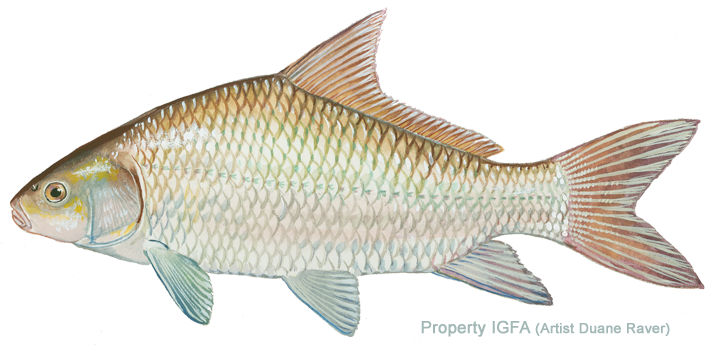Game Fish Identification Reference Guides
Buffalo, bigmouth
(Ictiobus cyprinellus)
(Ictiobus cyprinellus)

(Valenciennes, 1844); CATOSTOMIDAE FAMILY
Found in the Lake Erie, Ohio, and Mississippi drainages from Canada to the Gulf of Mexico, the bigmouth buffalo has also been introduced into Arizona and California.
It is the largest member of the sucker family, growing to over 70 lb (31 kg). In general body shape it very much resembles the carp. The dorsal fin is similar, beginning with a tall lobe near the middle of the back and continuing to a lower portion nearly to the tail. The carp has a single serrated spine at the beginning of the dorsal fin, while the bigmouth buffalo has no spines in any of the fins. The toothless mouth is relatively large and wide, and slants downward when closed. The upper lip begins almost on a level with the eyes. In comparison, the mouth of the smallmouth buffalo (Ictiobus bubalus), is smaller, almost horizontal when closed, subterminal and protracts downward in typical sucker fashion. The body of the bigmouth buffalo is coppery olive brown to slate blue above, becoming lighter toward the belly, which is white.
About 90 percent of the bigmouth buffalo's diet consists of small crustaceans. It also feeds on algae and other plant matter, but very seldom eats insects, insect larvae, or other fish. Consequently, the species does not form a large sport fishery since it will not take the normal types of baits
Found in the Lake Erie, Ohio, and Mississippi drainages from Canada to the Gulf of Mexico, the bigmouth buffalo has also been introduced into Arizona and California.
It is the largest member of the sucker family, growing to over 70 lb (31 kg). In general body shape it very much resembles the carp. The dorsal fin is similar, beginning with a tall lobe near the middle of the back and continuing to a lower portion nearly to the tail. The carp has a single serrated spine at the beginning of the dorsal fin, while the bigmouth buffalo has no spines in any of the fins. The toothless mouth is relatively large and wide, and slants downward when closed. The upper lip begins almost on a level with the eyes. In comparison, the mouth of the smallmouth buffalo (Ictiobus bubalus), is smaller, almost horizontal when closed, subterminal and protracts downward in typical sucker fashion. The body of the bigmouth buffalo is coppery olive brown to slate blue above, becoming lighter toward the belly, which is white.
About 90 percent of the bigmouth buffalo's diet consists of small crustaceans. It also feeds on algae and other plant matter, but very seldom eats insects, insect larvae, or other fish. Consequently, the species does not form a large sport fishery since it will not take the normal types of baits













